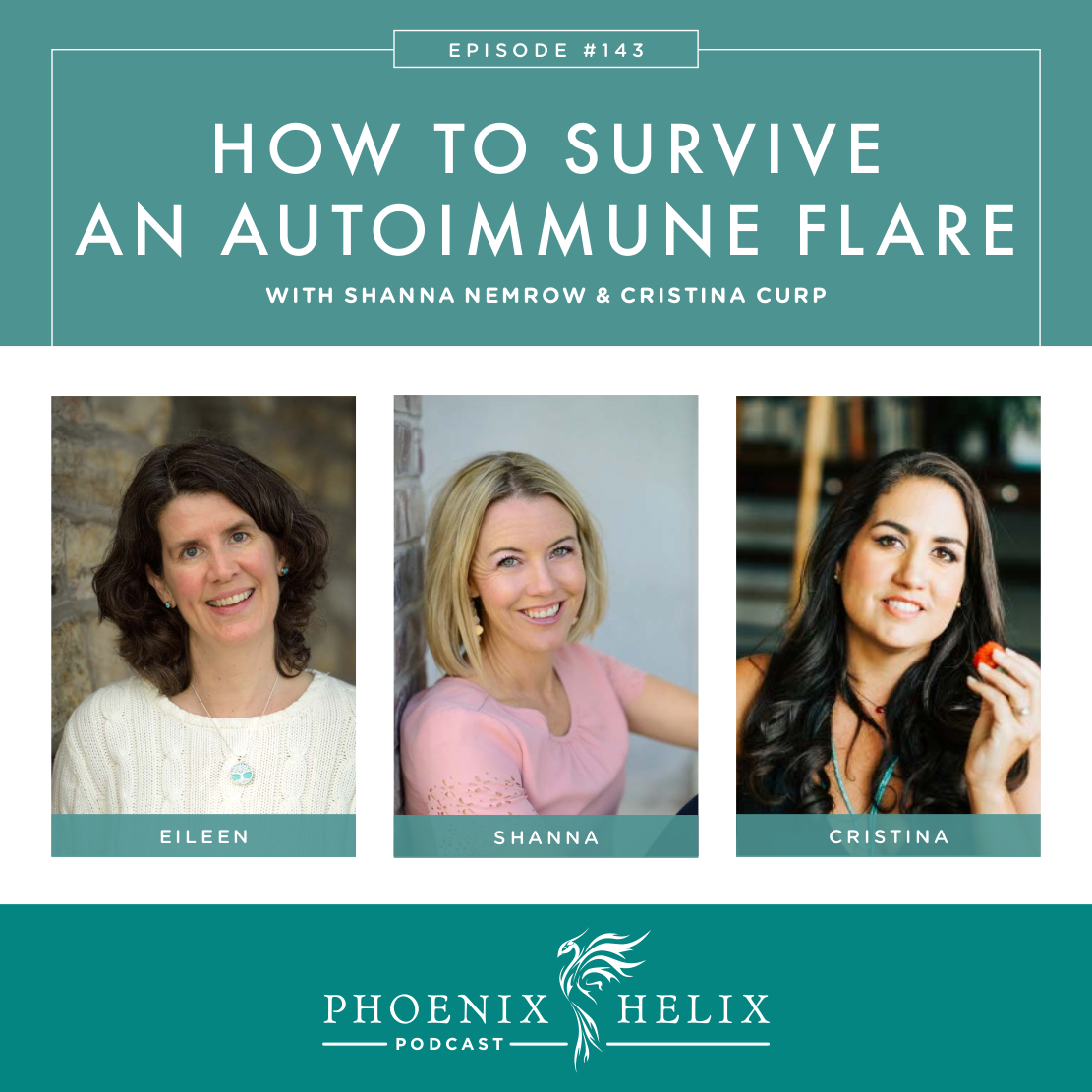
Autoimmune Flare-Ups
They’re one of the scariest parts of autoimmune disease. They’re unpredictable, often very painful, sometimes disabling, and always disruptive to our plans. In this episode, three autoimmune warriors share their best tips for making it through autoimmune flares with strength and self-compassion. We talk about favorite foods, lifestyle hacks, mindset techniques, and more.
Listen to the Show
- Subscribe to my podcast through your favorite podcast app: iTunes, Stitcher, Google, TuneIn, Spotify, Amazon, etc.
- You can also listen to the episode right here through the player below, and if you subscribe to my newsletter you’ll get notified of future episodes.
Podcast: Play in new window | Download
Show Notes
- Intro (0:00)
- Meet Our Guests
- Two of my favorite people are joining me for today’s podcast. They are both writers, nutritional therapy practitioners, and autoimmune warriors.
- Cristina Curp is the blogger behind The Castaway Kitchen and the author of two paleo cookbooks: Made Whole and Made Simple. he’s a strong voice in the community of nutritional healing and writes beautifully about loving your body with its flaws, rather than in spite of them. Cristina has an autoimmune skin condition called hidradenitis suppurativa.
- Shanna Nemrow has Hashimoto’s thyroiditis and writes and speaks about all aspects of the paleo autoimmune protocol: diet, lifestyle, and mindset. It’s her personal and professional mission to help people find joy and live well with autoimmune disease.
- Thank You to Our Podcast Sponsor: ShopAIP (2:33)
- When you’re in the middle of an autoimmune flare, preparing food can be extremely hard to do. It’s helpful to have some shelf-stable, nutrient-dense snacks in your pantry. ShopAIP has a great selection of canned protein and protein bars, collagen powder, and instant soups and stews.
- ShopAIP is an online store dedicated to the Paleo Autoimmune Protocol. With hundreds of items for the elimination phase of the AIP, and new products labeled by reintroduction category as well. You can find protein bars, sauces and condiments, AIP-friendly spices, cooking and baking ingredients, delicious snacks, non-toxic skincare, and more.
- If you’re a first-time customer, use the code PHOENIX for 10% off your order. Purchase here.
- Our Personal Experience with Autoimmune Flares (3:29)
- There are over 100 autoimmune diagnoses, and flares manifest a little differently for each of us, yet there’s also overlap in the way it impacts our life.
- Cristina: Hidradenitis suppurativa (HS) usually affects the skin where it folds and rubs together (inner thighs, groin, under breasts, buttocks, and armpits). Symptoms include painful boils and abscesses. When severe, they can form in clusters connected via tunnels under the skin, and get as big as a golf ball. They frequently become infected and leave scars behind. Cristina developed this condition when she was 13 years old. Her symptoms were at their worst in her 20’s, and she was in a constant state of flare for 10 years. She took NSAID’s daily and frequent antibiotics. Her whole world revolved around managing pain, her appearance, and her self-esteem. She was in her 30’s when she realized diet and lifestyle played a role in her condition. Now, she’s in remission as long as she manages her stress and avoids her trigger foods (nightshades, gluten, and she also needs to limit sugar). Flares are rare now – her last one was over a year ago. When a flare does happen, she knows what to do to shorten its duration and intensity. For Cristina, the first signs of a flare are general bodywide inflammation, including joint stiffness, headaches, gum swelling, and a warm sensation under her skin. If she takes self-care steps to reduce the inflammation right away, she can often stop a flare before it starts.
- Shanna: Hashimoto’s disease attacks the thyroid, and the symptoms can be wide-ranging. It’s not uncommon to take years to get a diagnosis. That was true for Shanna – her labs kept coming back “normal”, and she tried to simply “push through”. When her symptoms were at their worst, she was experiencing hair loss, cold intolerance, joint and muscle pain, brain fog, daily low-grade fevers, frequent illness, and debilitating fatigue. She had trouble getting out of bed, needed to rest after taking a shower, and couldn’t make it up a flight of stairs without resting half-way. She also experienced what she calls “daily storms” within her body, where she would become sensitive to light, movement, and sound, and need to lie down in a dark room until it passed. It was a frightening and isolating period in her life. Finally in late 2017, a naturopath ordered a thyroid ultrasound which led to her diagnosis. She started the AIP within a few days after learning she had autoimmune disease, and it’s played a big role in her health ever since. She noticed improvements within just a few months, but she continues to feel better and better as she focuses on nutrient density and a healthy lifestyle (prioritizing sleep, stress management, time in nature, social connection, and healthy movement.) Flares are rare now, much less severe, shorter in duration, and easier for her to manage. Sometimes she even forgets she has Hashimoto’s. Her first signs of a flare are fatigue, mild brain fog, and a low-grade fever. Instead of pushing through, she now pulls back and focuses on self-care to stop the flare before it starts. Usually that works, but occasionally a flare will happen in spite of her best efforts. She’s actually recovering from one right now, but she knows how to support herself.
- Eileen: Rheumatoid arthritis attacks the joints bodywide, but the hands, wrists, and feet are hallmarks of the condition. A flare can be excruciatingly painful, particularly with movement, which is one of the reasons they’re often disabling. I experienced severe and rapid onset. My first symptom appeared in one toe, and within a few months, flares were happening bodywide that took away my ability to work, walk, and perform daily tasks. Sleep was almost impossible. I felt like I was 90 years old when I got up in the morning, and that was the good part of my day. Each night, a different joint would become severely inflamed – I called it flare Russian roulette. I never knew which joint would get hit, but I would have to immobilize it. If it was my shoulder, it went into a sling. If it was my wrist, it went into a brace. If it was my knee, I had to get off my feet for the rest of the night. And if it was my jaw, I couldn’t open my mouth to speak or eat. It was a terrifying and excruciatingly painful time in my life. That was 2012. Now, years later, a combination of diet, lifestyle, mindset, and medication keep me in remission most of the time. Flares are rare and much milder than before. I get occasional brief joint pain that doesn’t require painkillers (I wouldn’t even call those flares). My biggest flare since I’ve been in remission was 1-1/2 years ago. My foot flared for two months, interfering with walking and physical activities. The unusual thing was that there was no clear cause. It was a happy, stress-free period in my life, with no food trigger. The flare seemed to come out of nowhere, and was likely triggered by the hormone fluctuations of perimenopause. While I would prefer to be able to prevent every flare, there was actually a grace and freedom when I realized I wasn’t in complete control, and didn’t need to put that kind of pressure on myself all of the time. Self-compassion is a big part of my autoimmune flare survival kit.
- Thank You to Our Podcast Sponsor: Paleo on the Go (31:04)
- A frozen meal delivery service, 100% of their menu is compliant with the elimination phase of the paleo autoimmune protocol (AIP). They have over 6o items, including entrees, side dishes, broth, AIP-friendly bacon, and desserts.
- Use the code PHOENIX for 10% off your first order.
- Nutritional Support During Flares (32:54)
- Healing diets overall help reduce the frequency and intensity of flares. That was true for all of us. (Resource: Comparison of 3 Healing Diets.)
- Eileen’s advice: During flares, there are foods that help, and foods that hurt. Remember: comfort food isn’t comforting if it causes you pain. Sometimes during a flare, we say, “Screw it! I feel bad anyway. I’m going to eat whatever I want.” There’s a reason we do this – it’s an immediate endorphin release in the brain that makes us feel better in the moment. Unfortunately, this usually extends and worsens a flare. We need to redefine our definition of “comfort food”. When you feel that impulse, pause and try to choose the foods that shorten your flare instead. (Resource: Overcoming Sugar Cravings.)
- Cristina’s preferred foods during a flare: Bone broth for gut healing, salmon for anti-inflammatory omega-3 fatty acids, and bone broth white rice cooked in the pressure cooker because it’s easy to digest. Sometimes she also finds fasting helpful. She flares rarely now, so doesn’t need to have a lot of food prepared in advance. But when she was flaring more frequently, she did a lot of batch cooking and stocked her freezer with homemade leftovers, as well Paleo on the Go Meals in her freezer. She recommends The Paleo AIP Instant Pot Cookbook and Freezer Cooking for the AIP.
- Shanna’s preferred foods during a flare: Soups made with bone broth, simple nutrient-dense AIP hashes, and water for hydration. She also follows her intuition about what to eat. In the past, that wouldn’t have worked, because she only craved junk food, but now she craves nourishing foods. Her cravings changed when she worked on her emotional eating patterns.
- Lifestyle Choices During Flares (45:16)
- Food is medicine, but it’s not the only medicine. Lifestyle practices are just as essential to health and flare recovery.
- Cristina’s favorite practices: Sleep (prioritizing it over things like watching a lot of TV). Epsom salt baths with a few drops of tea tree or oil of oregano. Getting support by asking for help, and also talking with someone who understands and is a good listener. If she knows she’s been exposed to a trigger food, she takes activated charcoal to clear it from her system more quickly. And these are her favorite supplements during a flare: magnesium and omega-3s.
- Shanna’s favorite practices: Sleep (10-12 hours a night during a flare, plus a nap during the day). Slowing down, being willing to cancel plans and prioritize rest. She used to be a people pleaser, so learning to set boundaries has been an important part of her health journey. Finally, managing stress is key. She loves restorative yoga and stretching, particularly the “legs up the wall” pose, which puts her in a relaxed state quickly.
- Eileen’s favorite practices: In addition to the ones already mentioned, I also consciously make room for joy. During a flare, a lot of my favorite activities are off the table, and emotionally it’s a difficult time. So, I focus on what’s still within my abilities that I enjoy, and I make an effort to do those things. For example, if I can’t walk or hike, I’ll take a scenic drive and bring my camera along to do some nature photography. It helps to shine a light for myself during dark times.
- Mind-Body Techniques During Flares (56:32)
- Our mind often goes to a very negative place during a flare. We feel like a failure. We fear the flare will never end. We feel hopeless. Mind-body techniques are powerful interventions for interrupting this negativity, and offering positivity in its place. Different ones resonate with each of us. Choose the ones that empower you.
- Cristina’s favorite practices: Affirmations – she writes them down in a journal and also repeats them to herself throughout the day. She also tries to avoid using the word “my” when it comes to her diagnosis. She doesn’t like to “own” her disease. Instead, she affirms her health. Trauma recovery – emotions and past traumas can surface during a flare. Getting therapeutic support can be a key to releasing the emotional triggers that drive autoimmune activity. Lastly, she has a mindset practice that was inspired by the Hawaiian ritual of Ho’oponopono. Every night during a flare, she repeats the following mantras to herself as she falls asleep: I love you. I’m sorry. Please forgive me. Thank you.
- Shanna’s favorite practices: She starts every day with a gratitude practice, and finishes every day celebrating her achievements. She finds that the gratitude practice changes her outlook. She lets herself feel all the emotions that arise during a flare, including grief, but now gratitude appears alongside. It was her husband’s idea to add the celebration practice at night. At rock bottom, she began by celebrating the simplest things, like getting out of bed and taking a shower. Each achievement is worth celebrating.
- Eileen’s favorite practices: I incorporate many of them into my life, but one of my favorites is meditation. It helped me at rock bottom when pain was all I could see or feel. It gave my mind another point of focus. While it didn’t shift my physical pain, it removed the panic I was feeling and greatly reduced my suffering. I still practice meditation today – on both good days and during flares. I particularly love the Body Scan Meditation. If you’re new to meditation and think you can’t do it, I have a podcast just for you: Ep. 91: Meditation for Fidgety Skeptics.
- Medication Decisions (1:08:34)
- Sometimes we come to this community with the goal of avoiding autoimmune medication, but not everyone achieves a medication-free remission. If you are practicing excellent self-care and still experiencing frequent flares, you might consult with your doctor about options. Diet, lifestyle, mindset, and medication can work well together. It doesn’t have to be an either/or choice.
- Resources: Eileen wrote 2 articles about her decision to start medication after 4 years on the AIP: Part 1 and Part 2. There’s also a podcast: Ep. 48 – Medication Decisions.
- Outro (1:10:01)
- You can keep up with Cristina Curp through her website, The Castaway Kitchen. She’s on all social media channels under the same name. Her cookbooks are Made Whole and Made Simple. Cristina also offers 1:1 nutritional therapy through the functional medicine practice of Dr. Becky Campbell.
- You can keep up with Shanna Nemrow through her website and YouTube channel. She’s also on all social media channels under her own name. She teaches an online AIP group coaching program and has a few limited 1:1 consultations available as well.
- Eileen (your podcast host) is the author of multiple books, written to help people thrive with autoimmune disease. Learn more on the Books Page.
- If you like this podcast, follow or subscribe through your favorite podcast app. You can also subscribe to Eileen’s biweekly newsletter.
- Check out the entire archive of podcast episodes.
You May Also Be Interested In
Spreading the Word
If you like the podcast, please leave a positive review in iTunes. It would mean the world to me, and also helps others find the podcast. Here are some quick instructions using your iPhone:
- If you are already subscribed to my podcast: (1) Click the purple podcast icon. (2) At the bottom of the screen, click Library. (3) At the top of the screen, click Shows. (4) Click the Phoenix Helix podcast image. (5) Scroll down the page, and you’ll see Ratings and Reviews. Scroll down a little bit more and click on Write a Review. This will bring up the review screen. Tap 5 stars (if you love the podcast), and then click in the title box, and it will bring up the keyboard. Enter a title and short review. (6) Click Send in the upper right corner. (7) Thank you! Positive reviews give the podcast a higher search ranking in iTunes, helping people find it and letting them know it’s a quality podcast and worth their time to listen.
- If you haven’t subscribed to my podcast: (1) Click the purple podcast icon. (2) In the lower right corner, click the magnifying class. (3) Type Phoenix Helix in the search box. (4) Click the podcast cover in the Show list. (5) If you’d like to subscribe, click the + sign at the top of the screen. (6) To write a review, scroll down the page, and you’ll see Ratings and Reviews. Scroll down a little bit more and click on Write a Review. This will bring up the review screen. Tap 5 stars (if you love the podcast), and then click in the title box, and it will bring up the keyboard. Enter a title and short review. (7) Click Send in the upper right corner. (8) Thank you! Positive reviews give the podcast a higher search ranking in iTunes, helping people find it and letting them know it’s a quality podcast and worth their time to listen.








My flares used to put me into panic attacks & anxiety. My fatigue was fatigued! The worst thing was, I had to keep my suffering to myself, and push through. I was horrible to myself because I didn’t know what was happening, & I was embarrassed to look so weak. After AIP- the entire protocol, not just the diet part- I learned self love. I used EFT to keep me afloat throughout my hashimoto’s hell. Subliminal therapy, meditation, sleep, a group of supportive women, etc. helped me get through flares which became less frequent & less debilitating. It was empowering once I knew the signs, & the steps I had to take to save me from drowning in my flare.
You have very helpful recommendations. Thank you. I will be sharing this with many others.
Pearl ❤️
Pearl, thank you so much for sharing your experience. What a powerful transformation, and so beautifully expressed! Here’s to self-love, feeling empowered, and surrounding ourselves with supportive people. For anyone reading this who would like to know more about EFT, listen to Episode 41. It’s a wonderful technique.